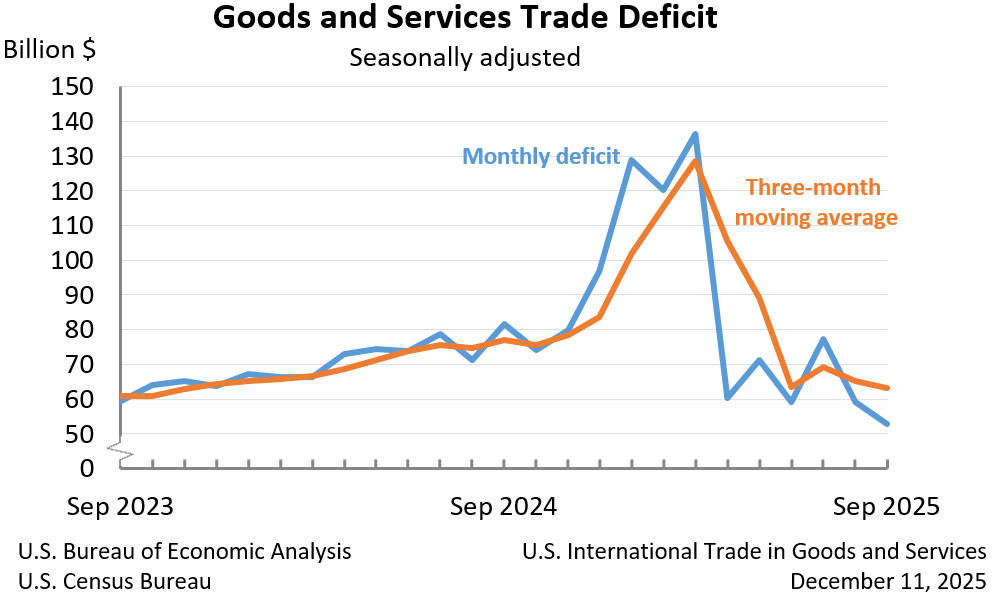Bureau of Economic Analysis
U.S. International Trade in Goods and Services, September 2025
The U.S. goods and services trade deficit decreased in September 2025 according to the U.S. Bureau of Economic Analysis and the U.S. Census Bureau. The deficit decreased from $59.3 billion in August (revised) to $52.8 billion in September, as exports increased more than imports. The goods deficit decreased $7.1 billion in September to $79.0 billion. The services surplus decreased $0.6 billion in September to $26.2 billion.
Principal Federal Economic Indicators
Noteworthy
The Latest
State Personal Income, Third Quarter 2019
State personal income increased 3.8 percent at an annual rate in the third quarter of 2019, a deceleration from the 4.4 percent increase in the second quarter. The percent change in personal income across all states ranged from 15.2 percent in South Dakota to 1.9 percent in West Virginia and Wyoming.
State Personal Income, Third Quarter 2019
State personal income increased 3.8 percent at an annual rate in the third quarter of 2019, a deceleration from the 4.4 percent increase in the second quarter. The percent change in personal income across all states ranged from 15.2 percent in South Dakota to 1.9 percent in West Virginia and Wyoming.
U.S. Virgin Islands GDP Increases 1.5 Percent in 2018
The estimates of GDP for the U.S. Virgin Islands show that real GDP—GDP adjusted to remove price changes—increased 1.5 percent in 2018 after decreasing 0.6 percent in 2017. For comparison, real GDP for the United States (excluding the territories) increased 2.9 percent in 2018 after increasing 2.4 percent in 2017.
Gross Domestic Product for the U.S. Virgin Islands (USVI), 2018
The estimates of GDP for the USVI show that real GDP—GDP adjusted to remove price changes—increased 1.5 percent in 2018 after decreasing 0.6 percent in 2017. For comparison, real GDP for the United States (excluding the territories) increased 2.9 percent in 2018 after increasing 2.4 percent in 2017.
A Look at Counties’ Economic Growth by Region
The first official economic growth statistics for all U.S. counties show which industries contributed to growth from region to region and in counties large, medium, and small across the nation.
These new Bureau of Economic Analysis statistics feature every county's gross domestic product – the value of goods and services produced within the county – and how much the inflation-adjusted GDP grew or decreased from the previous…
BEA's First Official County GDP Stats
Real gross domestic product (GDP) increased in 2,375 counties, decreased in 717, and was unchanged in 21 in 2018, according to estimates released today by the U.S. Bureau of Economic Analysis (BEA). The percentage change in real GDP ranged from 86.5 percent in Jackson County, WV, to -44.0 percent in Grant County, ND.
Local Area Gross Domestic Product, 2018
Real gross domestic product (GDP) increased in 2,375 counties, decreased in 717, and was unchanged in 21 in 2018, according to estimates released today by the U.S. Bureau of Economic Analysis (BEA). The percentage change in real GDP ranged from 86.5 percent in Jackson County, WV, to -44.0 percent in Grant County, ND. In 2020, data for counties and metropolitan areas will be contained in a news release called Gross Domestic Product by County…
Guest Blog: New County GDP Data Will Help County Leaders Strategize and Plan
By Teryn Zmuda, Director of Research and Data Analytics at the National Association of Counties.
A new county economic measure will be released this week, providing an in-depth and detailed look into county economies — allowing county leaders to identify areas of strength and opportunity within the county lines. The measure is a county-level estimate of gross domestic product, or GDP, which will be released by the Bureau of Economic Analysis…
October 2019 Trade Gap is $47.2 Billion
The U.S. monthly international trade deficit decreased in October 2019 according to the U.S. Bureau of Economic Analysis and the U.S. Census Bureau. The deficit decreased from $51.1 billion in September (revised) to $47.2 billion in October, as imports decreased more than exports. The previously published September deficit was $52.5 billion. The goods deficit decreased $3.7 billion in October to $68.0 billion. The services surplus increased $…
U.S. International Trade in Goods and Services, October 2019
The U.S. monthly international trade deficit decreased in October 2019 according to the U.S. Bureau of Economic Analysis and the U.S. Census Bureau. The deficit decreased from $51.1 billion in September (revised) to $47.2 billion in October, as imports decreased more than exports. The previously published September deficit was $52.5 billion. The goods deficit decreased $3.7 billion in October to $68.0 billion. The services surplus increased $0.2…




